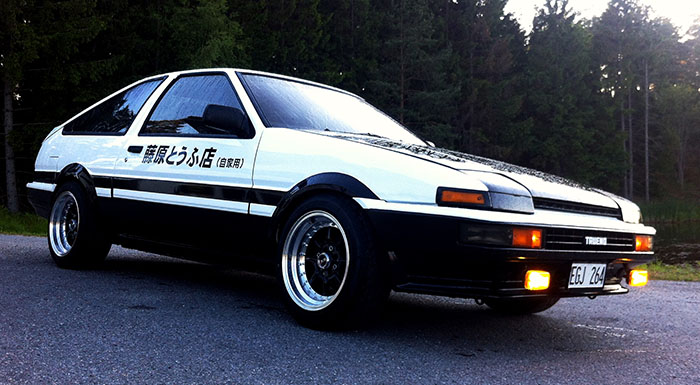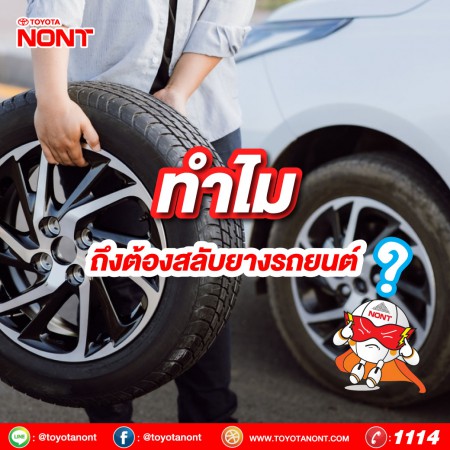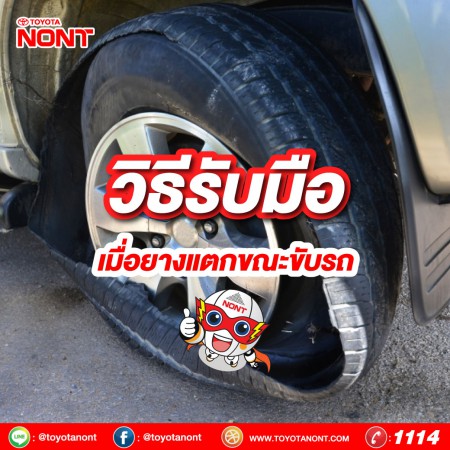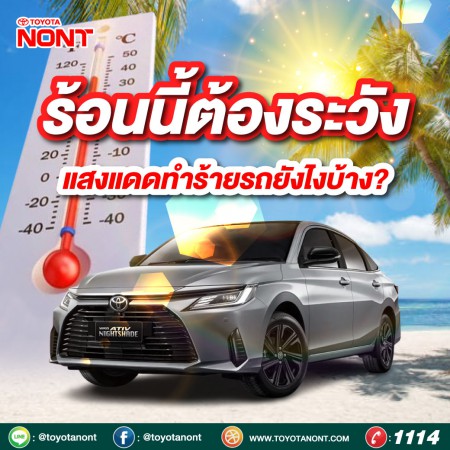

Toyota AE86
The AE86 generation of the Toyota Corolla Levin and Toyota Sprinter Trueno is a small, lightweight coupe introduced by Toyota in 1983 as part of the fifth generation Toyota Corolla lineup. For the purpose of brevity, the insider-chassis code of "AE86" depicts the 1600 cc RWD model from the range. In classic Toyota code, the "A" represents the engine that came in the car (4A series), "E" represents the Corolla, "8" represents the fifth generation (E80 series) and "6" represents the variation within this generation.
The Levin has fixed-headlights, and the Trueno has retractable headlights, both could be hatchback or coupe. The export model name Corolla covers both variations. The AE86 (along with the lower spec 1,452 cubic centimetres (1.452 L) AE85 and 1587 cc SR5 versions) was rear wheel drive (unlike the front wheel drive CE80, EE80 and AE82 models), and is among the last rear-drive cars of its type, at a time when most passenger cars were being switched to front-drive. In 1987, there was a limited edition model of the AE86 called "Black Limited" that served as a send-off model before the AE86 chassis was replaced later that year by the front wheel drive AE92 Corolla/Sprinter range.
In Japan, the AE86 was also known as the Hachi-Roku (ハチロク?), Japanese for "eight-six". In Japan, the Sprinter Trueno was exclusive to Toyota Japan dealerships called Toyota Vista Store, while the Corolla Levin was exclusive to Toyota Corolla Store. The word "trueno" is Spanish for thunder, and "levin" is Old English for "lightning".
The AE86 later inspired the Toyota 86 (also badged as the Scion FR-S and Subaru BRZ.)[1]
Engine/technical
The AE86 was available with a fuel-injected 4-cylinder twin-cam 1587 cc 4A-GE engine in Japan and Europe which was also used in the first-generation Toyota MR2 (AW11). This engine had a maximum gross power output of 130 PS (96 kW) and 110 lb·ft (150 N·m) of torque in standard form, though it was later down-rated to 120 PS (88 kW) and 105 lb·ft (142 N·m) in net output.[2][3] The AE86 came with a 5-speed manual gearbox, and later came with the option of an automatic. The 4A-GE engines used in the AE86 and AW11 were equipped with T-VIS (Toyota Variable Intake System). The AE86 had an optional LSD.[2] In North America, a modified 4A-GEC engine was used to comply with California emissions regulations. Power was rated at 112 bhp (84 kW), and 96 lb·ft (136 Nm) of torque.[2] The AE86 used ventilated disc brakes. The car was equipped with a MacPherson strut style independent suspension at the front and a four-link live axle with coil springs for the rear. Stabilizer bars were present at both ends.[2]
Lower-spec American AE86 SR5 models used the 1587 cc 4A-C SOHC unit, did not have an optional LSD, and had rear drum brakes. Also, the SR5 model had a softer suspension, and small styling and interior changes.
Models equipped with the 4A-GE engine received a 6.7" rear differential, while 4A-U, and 4A-C models received a smaller, weaker, 6.38" rear differential.
The AE86 SR5 (4A-C equipped) had an optional automatic transmission, though the GT-S model (with the 4A-GE DOHC engine) only came with a standard 5-speed manual gearbox. One of the staff who was behind the car's engineering work was Nobuaki Katayama, who would later head the company's motorsport department and who would become chief engineer of the Altezza project a decade later.[citation needed] An article in Car Magazine in April 1999, stated he has a photo of an AE86 hung in his office.
Body styles
Both the Levin and Trueno variants were offered with either a 2-door coupe or 3-door liftback (sometimes called hatchback) body style. The Levin and Trueno were generally identical, apart from fixed, rectangular headlights on the Levin and pop-up headlights on the Trueno. Minor bodywork changes were made in 1986 which resulted in different tail lights for both Levin and Trueno models, along with the coupe and hatchback styles. The models sold between 1983–1985 are sometimes referred to as "zenki" (前期, lit. early period), and the models sold from 1986–1987 are referred to as "kouki" (後期, lit. latter period).[4] The coupe version is considered to be the more rigid and lighter version of the two.
Models/specifications
In Japan, the DOHC 4A-GEU AE86 was offered in GT, GT-APEX and GTV trims as the Corolla Levin or Sprinter Trueno. In North America, the top-spec DOHC 4A-GEC was sold as the Corolla GT-S (with AE86 on the build plate in the engine bay but AE88 in the VIN), with the SOHC 4A-C being sold as the Corolla SR5 (with AE86 on the build plate and in the VIN). Both versions were sold with pop-up headlights only. Euro spec models were sold as the Corolla GT with DOHC engines and fixed Levin-style headlights. The Middle East received the same basic model as the North American market, with pop-up headlights and the regulated 5 mph (8 km/h) bumpers.
The lightest AE86 is the Japanese 2 door GT model which weighs 910 kg (2,006 lb). It has the same exterior as the GTV trim, but with the interior of the AE85 with the exception of the gauges, and is equipped with rear drum brakes.
North American AE86 specifications
There are three types of Corolla Sport RWD for the US market: DX, SR5, and GT-S, though the DX was generally an internal Toyota designation, as brochures, and advertising do not include the DX designation;[2] it consisted of a lower trim level, lighter duty suspension parts and the like.
Model Years of production: 1983 to 1987
Versions: DX, SR5 and GT-S (85+ Only)
Drag Coefficient: 0.39
DX & SR5 specifications
Chassis code: AE86 (which may differ from the VIN)
Horsepower: 87 hp (64 kW) @ 4800 rpm* Torque: 85 lb·ft (115 N·m) @ 2800 rpm*
Weight: approximately 2200 lb (998 kg) to 2400 lb (1089 kg)
Engine: 4A-C, 1587 cc
Engine type: SOHC 8-valve Inline-4 carburated
M/T transmission: T50, 6-bolt flywheel
A/T transmission: A42DL, 4-speed overdrive w/lockup torque converter, mechanically controlled, with electronically engaged overdrive
Compression: 9.0:1
Differential: 6.38" Open with 4.10:1 Ratio, 2-pinion (Automatic) (S292) or 3.91:1 ratio, 4-pinion (5-speed) (S314)
Wheels/tires: 13x5" +33 mm offset rims with 185/70R13 tires
First 7 characters of VIN: JT2AE85 (DX) or JT2AE86 (SR5)
[edit]GT-S specifications
Chassis code: AE86 (which may differ from the VIN)
Horsepower: 112 hp (84 kW) @ 6600 rpm* Torque: 97 lb·ft (132 N·m) @ 4800 rpm*
Weight: approximately 2200 lb (998 kg) to 2400 lb (1089 kg)
Engine: 4A-GE, 1587 cc
Engine type: DOHC 16-valve Inline-4 AFM Multiport Fuel Injection w/T-VIS
Transmission: T50, 8-bolt flywheel
Injector size: approx. 180 cc, low impedance
Compression: 9.4:1
Differential: 6.7" Open (T282) or optional LSD (USA Only) (T283) with 4.30:1 Ratio, 2-pinion Wheels/tires: 14x5.5" +27 mm Offset Rims with 185/60R14 82H Tires (195/60R14 85H for 86+ models)
First 7 characters of VIN: JT2AE88
The AE86 in motorsports
During its production life, the AE86 was a popular choice for showroom stock, Group A, and Group N racing, especially in rallying and circuit races. Even after production of the car was discontinued, many privateer teams still raced the AE86, and it is still a popular choice for rallying and club races today. Part of the continued appeal of the AE86 for motorsports is its rear-drive configuration, a feature not available in most newer lightweight coupes. In Group A world rally cars (1600 cc class) the 4A-GZE engine was popular. In Group A touring car races, the car either dominated the lower category where eligible or fought it out with Honda Civics or the later AE92s and AE101s whilst maintaining its competitiveness. In Ireland, where rallying is considered one of the most popular forms of motorsport, as organizing regulations are more relaxed compared to that of other countries, the AE86 was popular when new, and is still so popular that teams will purchase cars from the UK due to local shortages. The AE86 is also popular for rally use in Finland, where the cars can be competitive in the F-Cup competition for naturally aspirated 2WD cars.
The semi-factory supported Kraft team entered a spaceframe Trueno at the JGTC with a 3S-GTE engine that came from a SW20 MR-2 Turbo producing about 300 hp (224 kW) for the JGTC GT300 regulations in 1998. Despite being popular with the racefans, the car had minor success and was abandoned from use halfway through the 2001 season in favor of a newly delivered MR-S.
The rear wheel drive configuration, combined with the AE86's light weight (approximately 2300 lb (950–970 kg) curb weight), balance and relatively powerful (and easy to tune) 4A-GEU engine made it popular among the Japanese hashiriya (street racers in Japanese), many of whom raced in mountain passes (touge in Japanese) where the corners suited the AE86 best, especially on the downhill.[2] Among those who utilized this car was Japanese racing legend Keiichi Tsuchiya also known as the Dori-Kin ("Drift King" in Japanese). Keiichi Tsuchiya helped popularize the sport of drifting, which involves taking a car on a set of controlled slides through corners.[2] The AE86's FR configuration made it well suited to this kind of cornering, and currently the car is a mainstay of drift shows and competitions.
In Popular Culture
The main character of the anime and manga Initial D, Takumi Fujiwara, uses his father's AE86 Trueno for racing and making his tofu deliveries. Also in Initial D, Itsuki Takeuchi drives an AE85 Levin, mistaken for an AE86 and Wataru Akiyama drives a supercharged AE86 Corolla Levin. Later on in the series, Shinji Inui drives the Notchback coupe version of the AE86 Trueno.
The popularity of the manga is cited as the main cause of the car's high resale price. [5] The Corolla Levin, the Sprinter Trueno, and a modified AE86 similar to the one depicted in Initial D are featured in the racing video game series Gran Turismo (series).








